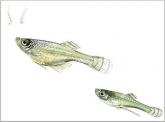Mosquitofish - Gambusia affinis
Originally from northern Mexico and the south-eastern United States of America, the Mosquitofish was first introduced in Italy in 1922 as a biological control against the Anopheles Mosquito, which carries the plasmodium causing Malaria.
This tiny fish, only 3-5 cm long, patrols the water surface in large groups looking for dipteran larvae on which it feeds. With its upward projecting mouth, the Mosquitofish can easily scoop up any immobile larvae as they replenish their oxygen supplies from the air.
Some observations suggest that in one day a single individual can swallow an amount of prey equal to its own body weight.
Unfortunately, the Mosquitofish is not content to stick to its role of Mosquito exterminator; it indiscriminately destroys small crustaceans, insects and their larvae and also the eggs of other fish, all of which has a negative effect on the ecological balance of the wetlands where it has made its home.
The Mosquitofish can live in all sorts of aquatic environments since it can tolerate salinity levels of over 20% and temperatures ranging from 0-28°C.
It spreads very quickly because of its particular way of breeding: it is in fact an ovoviparous species, and 3-6 times year the female "gives birth" to as many as 100 perfectly formed young.
This means that her eggs not only escape predation, but any other negative environmental factors too. Locally the Mosquitofish is also known by its picturesque name of "Buzzacchiotto" or "Little Pot-Belly", because the females have a swollen abdomen for most of the year.




